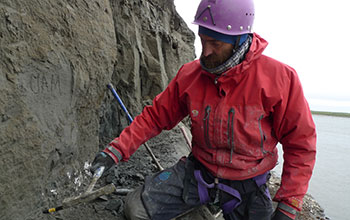Multimedia Gallery
Earth science curator Pat Druckenmiller digs for dinosaur bones along the Colville River
Pat Druckenmiller, an Earth science curator at the University of Alaska Museum of the North, digs for dinosaur bones along the Colville River in a remote area of northern Alaska.
More about this image
Researchers working with specimens at the University of Alaska (UA) Museum of the North described the new species in the international quarterly journal Acta Palaeontologica Polonica.
U. kuukpikensis (pronounced "oo-GREW-na-luck KOOK-pik-en-sis") once roamed the North Slope of Alaska in herds, living in darkness for months at a time and probably experiencing snow. They grew up to 30 feet long and were superb chewers with hundreds of individual teeth well suited for eating coarse vegetation.
The majority of the bones used in the study came from the Liscomb Bone Bed, a fossil-rich layer along the Colville River in the Prince Creek Formation, a unit of rock deposited on the Arctic flood plain about 69 million years ago.
"Today we find these animals in polar latitudes," says Pat Druckenmiller, an Earth sciences curator at UA Museum of the North. "Amazingly, they lived even farther north during the Cretaceous Period. These were the northern-most dinosaurs to have lived during the Age of Dinosaurs. They were truly polar."
The research was supported in part by National Science Foundation grant EAR 1226730.
To learn more about this research, see the UA Fairbanks news story New dinosaur species discovered on Alaska's North Slope. (Date image taken: 2013-2014; date originally posted to NSF Multimedia Gallery: Nov. 23, 2015)
Credit: Gregory M. Erickson, Florida State University
Images and other media in the National Science Foundation Multimedia Gallery are available for use in print and electronic material by NSF employees, members of the media, university staff, teachers and the general public. All media in the gallery are intended for personal, educational and nonprofit/non-commercial use only.
Images credited to the National Science Foundation, a federal agency, are in the public domain. The images were created by employees of the United States Government as part of their official duties or prepared by contractors as "works for hire" for NSF. You may freely use NSF-credited images and, at your discretion, credit NSF with a "Courtesy: National Science Foundation" notation.
Additional information about general usage can be found in Conditions.
Also Available:
Download the high-resolution JPG version of the image. (4.1 MB)
Use your mouse to right-click (Mac users may need to Ctrl-click) the link above and choose the option that will save the file or target to your computer.



 All images in this series
All images in this series